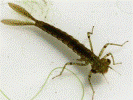DAMSEL FLIES FOR BLUEBILL (part I - Nymphs)
Before a trial in Evangeline Parish the attorneys were examining potential jurors. The prosecuting attorney called his first witness, a grandmotherly, elderly woman to the stand. He approached her and asked, "Mrs. Garcon, do you know me?"
She responded, "Why, yes, I do know you, Lawyer Breaux. I've known you since you were a young boy, and frankly, you've been a big disappointment to me. You lie, you cheat on your wife, and manipulate people out of their hard earned money, then talk about them behind their backs. You think you're a big shot when you haven't the brains to realize you'll never amount to anything more than a two-bit crooked paper pusher. Yes, I know you."
Lawyer Breaux was stunned. He pointed across the room and asked, "Mrs. Garcon, do you know the defense attorney?"
She again replied, "Why, yes, I do. I've known Lawyer Arneaux since he was a youngster, too. He's lazy, bigoted, and he has a drinking problem. He can't build a normal relationship with anyone and his law practice is one of the worst in the entire state. Not to mention he cheated on his wife with three different women. One of them was your wife. Yes, I know him."
Lawyer Arceneaux cringed.
Then Judge Olivier asked both counselors to approach the bench and, in a very quiet voice, said, "If either of you idiots asks her if she knows me, I'll have you disbarred."
It is often necessary to ask the right question. "What is the best fly to use for bluegill?" is such a question. Of course, no two people will give you the same answer.
Adult bluegill feed primarily on insects. That means they will eat insects to the exclusion of everything else unless food is scarce enough to force them to seek out other items. They will eat insects in any stage of the insect's life cycle and are not particular; eating whatever insect is currently available. However, should availability include damsel flies, they will usually be near the top of the menu.
Aquatic insects make up about seventy-five percent of a bluegill's diet. The variety of these insects is huge, with common aquatic versions including, but not limited to caddis flies (thousands of species), mayflies (more thousands of species), odonata (thousands of dragon and damsel flies), stoneflies and midges. Each of these may (but don't always) have a distinctive size, shape, skin or shell with a color and texture variation. The remaining twenty-five percent is mostly composed of terrestrial insects. Of the half million terrestrial insect species, bluegill have greater opportunity to feast on beetles, hoppers and ants than any others. The preferred meal is one that is large enough to be worth the effort, but not so large that it will be difficult to swallow. Such a prey is the damsel fly. [Interesting fact: Damsels actually date back 300 million years, to the Carboniferous Period of the Paleozoic Era.]
During the spring, damsel fly nymphs are particularly active. Damsel flies do not go through
the larva and pupa stages. Instead, the newly hatched damsel is a light colored nymph  and, as it grows, it simply becomes a larger nymph. Nymphs range from around 3/4 to 2 inches and the nymph will molt about a dozen times (this differs with altitude and latitude) and, with each molt, will increase in size and change from a light yellow/tan toward olive/brown. The nymph stage may last more than a year and offers the fly fisherman the opportunity to use larger flies (hook size 12-8). Bluegills are usually aggressive when eating damsels and recognizing a take does not require guesswork. (Photo from tjsgarden.com)
and, as it grows, it simply becomes a larger nymph. Nymphs range from around 3/4 to 2 inches and the nymph will molt about a dozen times (this differs with altitude and latitude) and, with each molt, will increase in size and change from a light yellow/tan toward olive/brown. The nymph stage may last more than a year and offers the fly fisherman the opportunity to use larger flies (hook size 12-8). Bluegills are usually aggressive when eating damsels and recognizing a take does not require guesswork. (Photo from tjsgarden.com)
Damsel flies hatch when water temperatures exceed fifty degrees and may hatch over extended periods. The first observation of mature damsels frequently indicates that a several week hatch is about to start.
Literally hundreds of damsel fly nymph patterns are available on the Internet (search for "damsel fly pattern" in Google or Bing images and you will find page after page of fly varieties), but there are always some similarities. Outside of Chernobyl, there are no multicolored, striped, fluorescent or polka dotted damsel nymphs. Smaller patterns should be light colored (often matching the color of the water) and larger patterns should be darker. Damsel fly nymph eyes are basically the same color as the body, but black is acceptable.
The body of the nymph is always elongated and the head is always broader than the body. The body can be created in many ways, a woven body is a good choice, but "close enough" patterns can be effective. Bodies of chenille, dubbing or plastic wrap/tubing with bead chain eyes are commonly used.
The tail can either be feathery and wing-like, or thin and pointed, and materials as widely different as biot, moose hair and marabou are all used in patterns. The key here is consistent color matching to the body.
The nymph should have enough weight to carry it to the bottom. The damselfly nymph is usually stationary, clinging to structure or vegetation on the bottom. Fishing requires patience because the nymph moves slowly and may stay motionless in the water or on the bottom. Weighting can be accomplished with lead wire wraps or bead chain eyes. Let the fly sink to the bottom (or to the vegetation or structure on the bottom) and retrieve it at a crawl.

photo from www. rspb.org.uk
